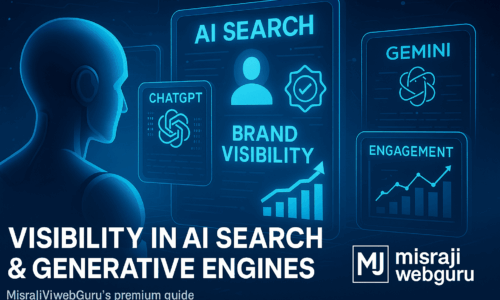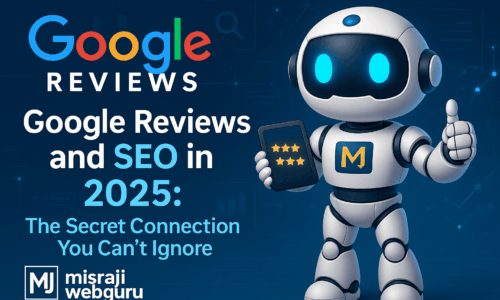
📑 Table of Contents
- Introduction: The Shift from Creation to Connection
- What is Generative AI?
- The Creative Power of Generative AI
- Why AI Matters for SEO
- From AI to Generative SEO
- Generative AI vs Generative SEO
- Applications of AI in SEO
- Case Story: Creativity Meets Visibility
- Mistakes Professionals Make in the AI Era
- FAQs on Generative AI and SEO
- Key Takeaways
- Conclusion: The Journey Ahead
The Shift from Creation to Connection
The internet has always been fueled by creativity. Blogs, designs, ads, videos—human imagination turned into content. But in 2025, Generative AI stepped in, changing not just how we create but how we connect.
At first, AI amazed us with creativity—writing poems, making designs, even producing code. But now, it has found a new role: shaping the way search engines deliver answers.
That bridge from creativity to visibility is what we call Generative SEO.
“AI creates, SEO connects. Together, they define the new internet.”
What is Generative AI?
Generative AI is artificial intelligence that doesn’t just analyze—it produces. It can:
- Write blog articles.
- Create artwork.
- Summarize complex topics.
- Generate answers like a teacher.
Unlike traditional AI, which predicted patterns, AI imagines new outputs. That’s why tools like Google Gemini and ChatGPT feel so human—they’re not just fetching; they’re creating.
The Creative Power of G-AI
When AI first gained popularity, it was celebrated for creativity. Writers used it for ideas, designers used it for visuals, businesses used it for content drafts.
Generative AI became the co-creator—always available, endlessly scalable.
But here’s the deeper shift: the same creativity is now applied in search. Instead of showing 10 blue links, Google now creates a summary answer—crafted by AI.
And the question every brand must ask is: “Am I part of that created answer?”
Why G-AI Matters for SEO
For professionals still chasing backlinks and keywords alone—pause.
AI matters because:
✔️ Google AI Overview runs on it.
✔️ Users get answers instantly—without clicks.
✔️ Only a few trusted voices are included.
That means even if you rank on page one, you may stay invisible unless AI chooses your content.
“The future of SEO is not ranking higher—it’s being selected.”
From AI to SEO (The Connection)
So, where does creativity meet visibility?
- Generative AI = the creative machine that produces answers.
- Generative SEO = the strategy that ensures your brand’s content is part of those answers.
In other words, Generative AI is the painter. Generative SEO is how you hang that painting in the most visible gallery.
Generative AI vs SEO (Two Sides of the Coin)
| AI | SEO |
|---|---|
| Creates answers and content | Positions content in those answers |
| Powers AI Overviews | Structures blogs for selection |
| Technology | Strategy |
| Creative tool | Competitive weapon |
Generative AI gives you creation.
Generative SEO gives you recognition.
Applications of AI in SEO
Here’s how professionals and freshers can use Generative AI in practice:
- Keyword Clustering → AI groups related queries to form topical hubs.
- Search Intent Analysis → AI understands why people search, not just what.
- Content Drafting → Speed up blog outlines, FAQs, headlines.
- Conversational Q&A → Write in natural tone for AI Overview selection.
- Continuous Updates → AI highlights fresh, updated content more often.
📌 “Generative AI is the brush. Generative SEO is the canvas.”
Case Story: Creativity Meets Visibility
A fashion brand we worked with produced stunning content—blogs, videos, designs. But despite creativity, they weren’t visible in AI-driven search.
We stepped in with SEO:
- Clustered keywords into themes like sustainable fashion trends 2025.
- Structured blogs with FAQs and conversational tone.
- Implemented schema markup.
- Updated old posts with new data.
Result? Within three months, their blogs were cited in Google AI Overview. Their creativity finally turned into visibility.
“Creativity without visibility is art unseen. Generative SEO makes it unforgettable.”
Mistakes Professionals Make in the AI Era
❌ Relying only on keyword stuffing.
❌ Treating AI as a content machine instead of a strategy partner.
❌ Ignoring FAQs and natural language.
❌ Leaving old blogs outdated.
❌ Believing Generative SEO is optional.
FAQs on Generative AI and Generative SEO
- What is Generative AI in SEO?
AI that creates contextual answers, not just search results. - What is Generative SEO?
The strategy of optimizing content for inclusion in AI-generated answers. - How do they work together?
Generative AI creates. SEO ensures your content gets cited. - Does this replace SEO?
No—it evolves SEO for the AI era. - Can small brands compete?
Yes. Clarity and intent matter more than big budgets. - What tools help?
Ahrefs, SEMrush, SurferSEO, AI keyword tools, schema generators. - How long before results show?
2–3 months with consistent updates. - Do I need technical expertise?
Basic schema helps, but clarity and structure are the foundation. - Why is this urgent in 2025?
Because Generative AI dominates how Google and others deliver answers. - What’s the ultimate benefit?
Being trusted as the voice in AI’s generated story.
Key Takeaways
- AI is transforming creativity into search answers.
- SEO ensures your content is included in those answers.
- The shift is from keywords → conversations, links → authority.
- Updated, structured, conversational content wins AI trust.
- The future is not about traffic—it’s about being the answer.
“AI paints the picture. Generative SEO frames it for the world to see.”
Conclusion: The Journey Ahead
If you’re a fresher, begin by learning how AI thinks. Write blogs that answer real questions.
If you’re a professional, embrace this shift—build clusters, update content, add structure.
At MisraJiWebGuru, I’ve seen the transformation: brands that pair creativity with visibility thrive.
“AI gives you creativity. Generative SEO turns it into credibility.”
In 2025, your journey is not just to create—but to connect. And the bridge is SEO.



